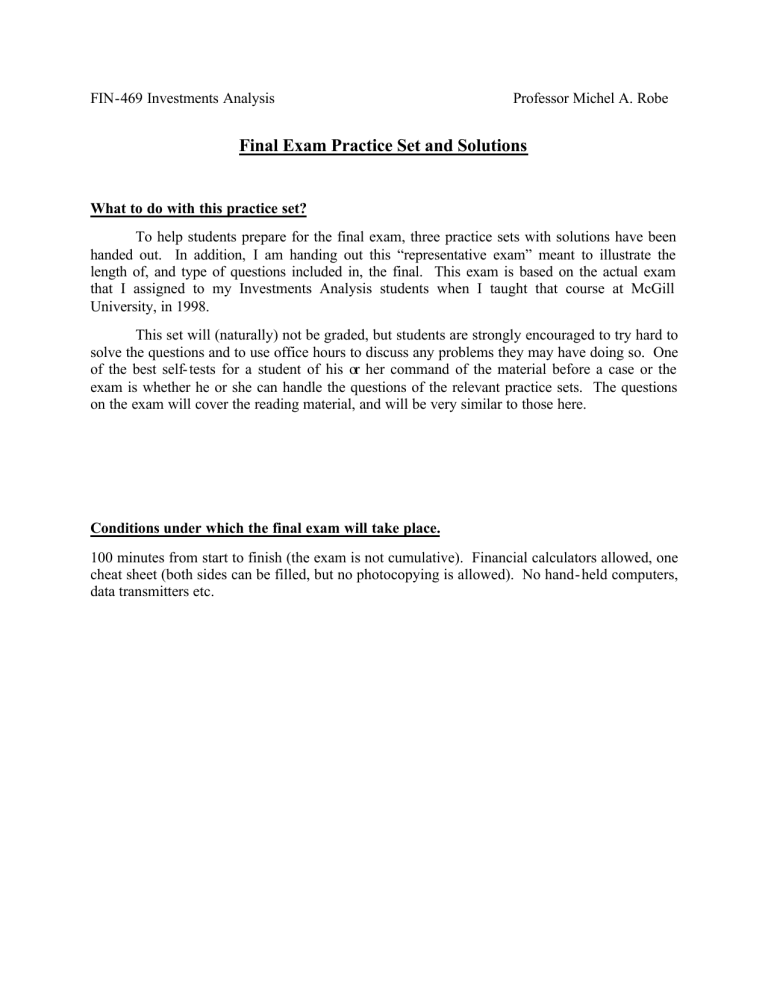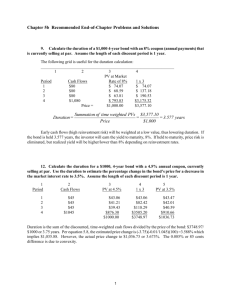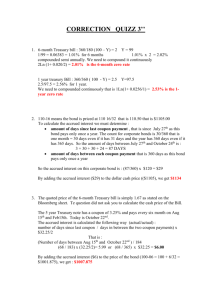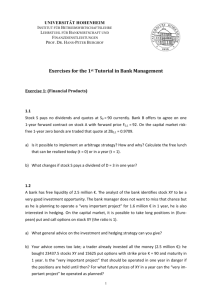Final Exam Practice Set and Solutions

FIN-469 Investments Analysis Professor Michel A. Robe
Final Exam Practice Set and Solutions
What to do with this practice set?
To help students prepare for the final exam, three practice sets with solutions have been handed out. In addition, I am handing out this “representative exam” meant to illustrate the length of, and type of questions included in, the final. This exam is based on the actual exam that I assigned to my Investments Analysis students when I taught that course at McGill
University, in 1998.
This set will (naturally) not be graded, but students are strongly encouraged to try hard to solve the questions and to use office hours to discuss any problems they may have doing so. One of the best self- tests for a student of his or her command of the material before a case or the exam is whether he or she can handle the questions of the relevant practice sets. The questions on the exam will cover the reading material, and will be very similar to those here.
Conditions under which the final exam will take place.
100 minutes from start to finish (the exam is not cumulative). Financial calculators allowed, one cheat sheet (both sides can be filled, but no photocopying is allowed). No hand- held computers, data transmitters etc.
Consider the following statement to answer Questions 1a-1d:
You manage a risky portfolio with an expected rate of return of 17% and a standard deviation of
27%. The Treasury-bill rate is 7%.
Question 1.a (2.5 points)
One of your clients chooses to invest 70% of a portfolio in your fund and 30% in a T-bill money market fund. What is the expected value and standard deviation of the rate of return on your client’s portfolio?
Question 1.b (2.5 points)
Suppose that your client decides to invest in your portfolio a proportion y of the total investment budget so that the overall portfolio will have an expected rate of return of 15%.
(a) What is the proportion y ?
(b) Further suppose that your risky portfolio includes the following investments in the give n proportions: Stock A (27%), Stock B (33%), and Stock C (40%). What are your client’s investment proportions in your three stocks and the T-bill fund.
Question 1.c (2.5 points)
Now suppose that your client prefers to invest in your fund a proportion y that maximizes the expected return on the overall portfolio subject to the constraint that the overall portfolio’s standard deviation will not exceed 20%.
(a) What is the investment proportion, y ?
(b) What is the expected rate of return on the overall portfolio?
Question 1.d (2.5 points)
Suppose that your client’s degree of risk aversion is A = 3.5. What proportion, y , of the total investment should you suggest that he invest in your fund?
Question 2 (7.5 points)
The market price of a security is $40. Its expected rate of return is 13%. The risk- free rate is 7% and the market risk premium is 8%. What will be the market price of the security if its covariance with the market portfolio doubles (and all other variables remain unchanged)?
Assume that the stock is expected to pay a constant dividend in perpetuity.
Question 3 (10 points):
(a) The agricultural price support system guarantees farmers a minimum price for their output. Describe the program provisions as an option. What is the asset? What is the exercise price?
(b) In what ways is owning a corporate bond similar to writing a put option? A call option?
Question 4 (7.5 points):
Which security should sell at a greater price? Explain briefly in each case.
(a) A 6- month European call option with a strike price of $60 or a 6- month European call on the same stock with an exercise price of $55?
(b) A 20-year Treasury bond with a 6.5% coupon rate or a 20-year Treasury bond with a 7.5% coupon rate? (bond portfolio management question)
(c) An American put option on a bond currently selling at $800, or an American put option on another bond selling at $860 (all other relevant features of the bond s and options may be assumed to be identical)?
Question 5 (10 points)
Rank the following bonds in order of descending duration:
Bond Coupon (%) Time to Maturity (Years) Yield to Maturity (%)
----------------------------------------------------------------------------------------------------
A
B
15
15
20
15
10
10
C
D
E
0
8
15
20
20
15
10
10
15
----------------------------------------------------------------------------------------------------
Explain, intuitively.
Question 6 (10 points)
Pension funds pay lifetime annuities to recipients. If a firm expects to remain in business indefinitely, its pension obligation will resemble a perpetuity. Suppose, therefore, that you are managing a pension fund with obligations to make perpetual payments of $2 million per year to beneficiaries. The yield to maturity on all bonds is 16%.
(a) If the duration of 5-year maturity bonds with coupon rates of 12% (paid annually) is 4 years and the duration of 20-year maturity bonds with coupon rates of 6% (paid annually) is 11 years, how much of each of these coupon bonds (in market value) will you want to hold to both fully fund and immunize your obligation?
(b) What will be the par value of your holdings in the 20- year coupon bond?
FIN-469 Investments Analysis Professor Michel A. Robe
Final Exam Practice Set Solutions.
Question 1.a:
Mean = (0.30 x 7%) + (0.7 x 17%) = 14% per year.
Standard deviation = 0.70 x 27% = 18.9% per year.
Question 1.b:
(a) Mean return on portfolio = R f
+ (R p
- R f
) y
= 7% + (17% - 7%) y = 7% + 10% y
If the mean of the portfolio is equal to 15%, then solving for y we will get:
15% = 7% +10% y => y = (15% - 7%)/10% => y = 0.8
Thus, in order to obtain a mean return of 15%, the client must invest 80% of total funds in the risky portfolio and 20% in Treasure bills.
(b) Investment proportions of the client’s funds:
•
20% in T-bills
•
0.8 x 27% = 21.6% in Stock A
•
0.8 x 33% = 26.4% in Stock B
•
0.8 x 40% = 32.0% in Stock C
Question 1.c:
(a) Portfolio standard deviation = y x 27%. If your client wants a standard deviation of 20%, then y = (20%/27%) = 0.7407 = 74.07% in the risky portfolio.
(b) Mean return = 7% + (17% - 7%) y = 7% + 10% (0.7407) = 7% + 7.407% = 14.407%.
Question 1.d: y * = (R p
- R f
)/0.01A
σ 2
=> y * = (17 - 7)/(0.01 x 3.5 x 27
2
) = 10/25.515 = 0.3919
Thus, the client’s optimal investment proportions are 39.19% in the risky portfolio and 60.81% in T-bills.
Question 2:
If the covariance of the security doubles, then so will its beta and its risk premium. The current risk premium is 6% (i.e., 13% - 7%), so the new risk premium would be 12%, and the new discount rate for the security would be 19% (i.e., 12% + 7%).
If the stock pays a level perpetual dividend, then we know from the original data that the dividend, D, must satisfy the equa tion for a perpetuity:
Price = Dividend/Discount rate => $40 = D/0.13 => D = $5.20.
At the new discount rate of 19%, the stock would be worth only $5.20/0.19 = $27.37. As a consequence, the increase in stock risk has lowered the stock value by 31.58%, i.e., ($27.37 -
$40)/$40.
Question 3:
(a) The agricultural price support system guarantees farmers a minimum price for their output.
Describe the program provisions as an option. What is the asset? What is the exercise price?
(b) In what ways is owning a corporate bond similar to writing a put option? A call option?
Answer
(a) The program gives the farmer a put option for its crop. The farmer has the option to sell the crop for a guaranteed minimum price to the government if the market price is too low. If P
S and P
M
denote the support price and the market price, respectively, then the farmer has a put option to sell the crop (the asset) at an exercise price of P
S
even if the price of the underlying asset, P
M
, is less than P
S
.
(b) The bondholders have in effect made a loan which requires repayment of B dollars, where B stands for the face value of bonds. If, however, the value of the firm, V, is less than B, then the bondholders take over the firm. In this case, the bondholders are forced to “pay” B (in the sense that the loan is cancelled) in return for assets worth only V. It is as though the bondholders wrote a put on an asset worth V with exercise price B.
Alternatively, one may view the bondholders as giving the right to the equity-holders to reclaim the firm by paying off the B dollar debt. They have written a call to the equityholders.
Question 4 (7.5 points):
Which security should sell at a greater price? Explain briefly in each case.
(d) A 6- month European call option with a strike price of $60 or a 6- month European call on the same stock with an exercise price of $55?
Solution:
The 6- month European call option with an exercise price of $55 will sell at a higher price. A call option gives its holder the right to buy the underlying security at the strike price. Therefore, since an option with a strike price of $55 allows the option holder to buy the shares at a lower price than another option with a strike price of $60 would, the holder of the first option has a higher chance of bigger profit when the strike price exceeds the price of the underlying asset.
(e) A 20-year Treasury bond with a 6.5% coupon rate or a 20-year Treasury bond with a 7.5% coupon rate? (bond portfolio management question)
Solution:
The 20- year Treasury bond with a 7.5% coupon rate will sell at a higher price because it offers a higher coupon payment. If the coupon rate is higher, then the price of the bond will be bid up, which causes an increase in the bond price.
(f) An American put option on a bond currently selling at $800, or an American put option on another bond selling at $860 (all other relevant features of the bond s and options may be assumed to be identical)?
Solution:
The put option on a bond selling at $800 will sell at a higher price. A put option gives its owner the right to sell the shares at a specific strike price: here, since the strike prices are assumed to be identical, a put option on a bond selling at a lower price of $800 therefore has a greater chance of being in-the- money.
Question 5 (10 points)
Rank the following bonds in order of descending duration:
Bond Coupon (%) Time to Maturity (Years) Yield to Maturity (%)
----------------------------------------------------------------------------------------------------
A 15 20 10
B 15 15 10
C
D
E
0
8
15
20
20
15
10
10
15
----------------------------------------------------------------------------------------------------
Explain, intuitively.
Solution:
C, D, A, B, E.
Question 6 (10 points)
Pension funds pay lifetime annuities to recipients. If a firm expects to remain in business indefinitely, its pension obligation will resemble a perpetuity. Suppose, therefore, that you are managing a pension fund with obligations to make perpetual payments of $2 million per year to beneficiaries. The yield to maturity on all bonds is 16%.
(c) If the duration of 5-year maturity bonds with coupon rates of 12% (paid annually) is 4 years and the duration of 20-year maturity bonds with coupon rates of 6% (paid annually) is 11 years, how much of each of these coupon bonds (in market value) will you want to hold to both fully fund and immunize your obligation?
(d) What will be the par value of your holdings in the 20- year coupon bond?
Solution:
(a)
•
PV of the firm’s “perpetual” obligation = ($2 million/0.16) = $12.5 million.
•
Based on the duration of a perpetuity, the duration of this obligation = (1.16/0.16) = 7.25 years.
Denote by w the weight on the 5-year maturity bond, which has duration of 4 years. Then, w x 4 + (1 – w ) x 11 = 7.25, which implies that w = 0.5357. Therefore,
0.5357 x $12.5 = $6.7 million in the 5- year bond and
0.4643 x $12.5 = $5.8 million in the 20- year bond.
The total invested amounts to $(6.7+5.8) million = $12.5 million, fully matching the funding needs.
(b) The price of the 20-year bond is 60 x PA(16%, 20) + 1000 x PF(16%, 20) = $407.11.
Therefore, the bond sells for 0.4071 times its par value, and
Market value = Par value x 0.4071
=> $5.8 million = Par value x 0.4071
=> Par value = $14.25 million.
Another way to see this is to note that each bond with a par value of $1,000 sells for $407.11.
If the total market value is $5.8 million, then you need to buy 14,250 bonds, which results in total par value of $14,250,000.








